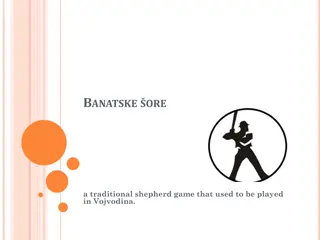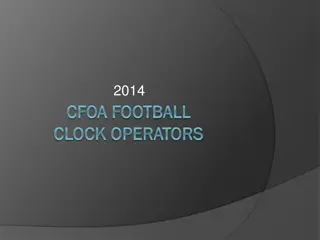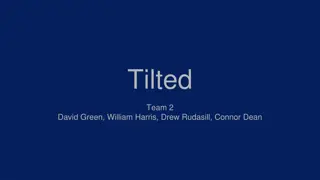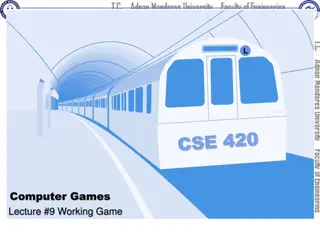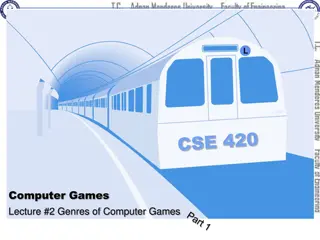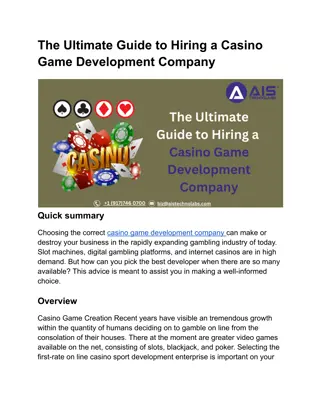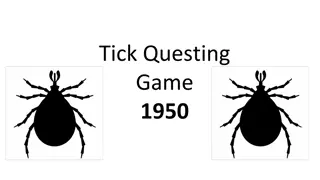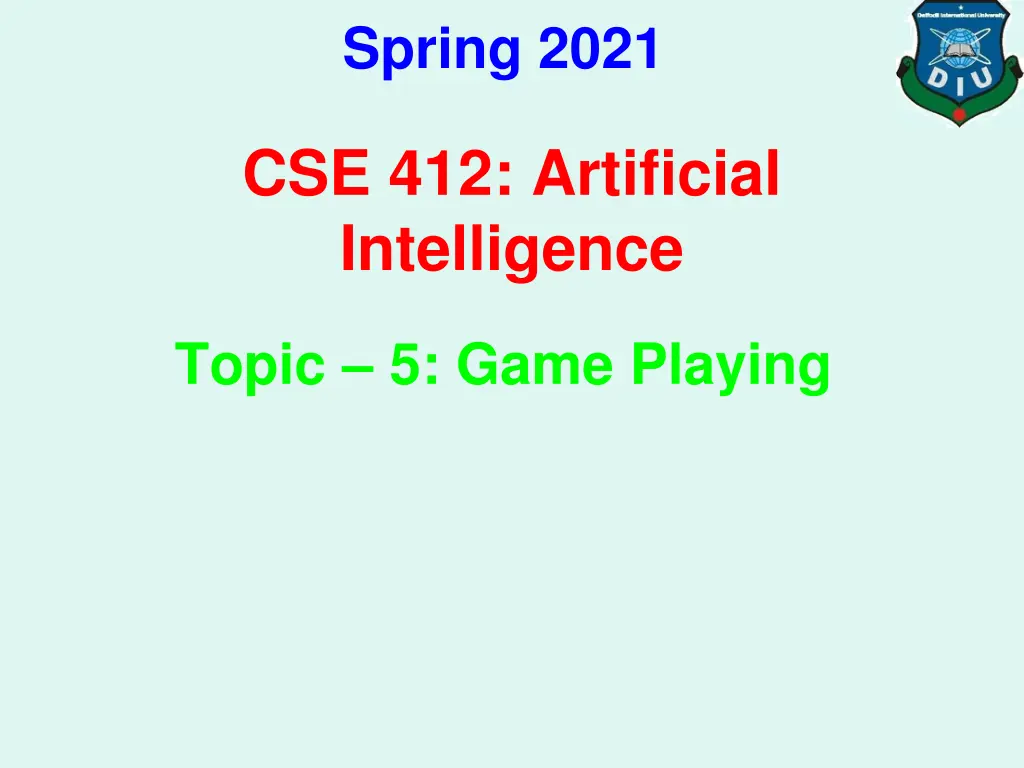
AI in Game Playing: Chess, Algorithms, and Search Strategies
Explore the intersection of artificial intelligence and game playing, focusing on the success of AI in defeating human champions like Gary Kasparov in chess. Learn about search-based approaches, optimal decision-making, and the evolution of AI in game playing. Discover the significance of games as a challenging problem for AI research, with examples from grandmaster chess matches and algorithms like Minimax and Alpha-Beta Pruning.
Download Presentation

Please find below an Image/Link to download the presentation.
The content on the website is provided AS IS for your information and personal use only. It may not be sold, licensed, or shared on other websites without obtaining consent from the author. If you encounter any issues during the download, it is possible that the publisher has removed the file from their server.
You are allowed to download the files provided on this website for personal or commercial use, subject to the condition that they are used lawfully. All files are the property of their respective owners.
The content on the website is provided AS IS for your information and personal use only. It may not be sold, licensed, or shared on other websites without obtaining consent from the author.
E N D
Presentation Transcript
Spring 2021 CSE 412: Artificial Intelligence Topic 5: Game Playing
Topic Contents Case Studies: Playing Grandmaster Chess Game Playing as Search Optimal Decisions in Games Greedy search algorithm Minimax algorithm Alpha-Beta Pruning
Case Studies: Playing Grandmaster Chess The real success of AI in game-playing was achieved much later after many years effort. It has been shown that this search based approach works extremely well. In 1996 IBM Deep Blue beat Gary Kasparov for the first time. and in 1997 an upgraded version won an entire match against the same opponent. 3
Case Studies: Playing Grandmaster Chess Kasparov vs. Deep Blue, May 1997 6 game full-regulation match sponsored by ACM Kasparov lost the match 1 wins to 2 wins and 3 tie This was a historic achievement for computer chess being the first time the best chess player on the planet. Note that Deep Blue plays by brute force (i.e. raw power from computer speed and memory). It uses relatively little that is similar to human intuition and cleverness. a computer became 4
Game Playing and AI Why would game playing be a good problem for AI research? game playing is non-trivial players need human-like intelligence games can be very complex (e.g. chess, go) requires decision making within limited time game playing can be usefully viewed as a search problem in a space defined by a fixed set of rules Nodes are either white or black corresponding to reflect the adversaries turns. The tree of possible moves can be searched for favourable positions. 5
Game Playing and AI Why would game playing be a good problem for AI research? games often are: well-defined and repeatable easy to represent fully observable and limited environments can directly compare humans and computers 6
Game Playing as Search Consider games e.g., tic-tac-toe, checkers, chess two-player, turn-taking, board Representing these as search problem: states: board configurations edges: legal moves initial state:start board configuration goal state: winning/terminal board configuration 7
Game Playing as Search: Game Tree What's the new aspect to the search problem? There s an opponent that we cannot control! X X X X X X O X O X X X O O O X X X X X O X X O O X O How can this be handled? 8
Adversarial search is search when there is an "enemy" or "opponent" changing the state of the problem every step in a direction you do not want. Examples: Chess, business, trading, war. You change state, but then you don't control the next state. 9
Game Playing as Search: Complexity Assume predicted given the computer's moves. the moves can be opponent s How complex would search be in this case? worst case: O(bd) ; b is branching factor, d is depth Tic-Tac-Toe: ~5 legal moves, 9 moves max game 59= 1,953,125 states Chess: ~35 legal moves, ~100 moves per game 35100~10154states, but only ~1040legal states ? Common trees. games produce enormous search 10
Greedy Search Game Playing ? A utility function maps each terminal state of the board to a numeric value corresponding to the value of that state to the computer. positive for winning, > + means better for computer negative for losing, > - means better for opponent zero for a draw typical values (lost to win): -infinity to +infinity -1.0 to +1.0 11
Greedy Search Game Playing Expand each branch to the terminal states Evaluate the utility of each terminal state Choose the move that results in the board configuration with the maximum value A 9 A computer's possible moves B C D E B -5 C 9 D 2 E 3 opponent's possible moves F G H I J K L M N O F -7 G -5 H 3 I 9 J -6 K 0 L 2 M 1 N 3 O 2 terminal states board evaluation from computer's perspective 13
Greedy Search Game Playing Assuming a reasonable search space, what's the problem with greedy search? It ignores what the opponent might do! e.g. Computer chooses chooses J and defeats computer. A 9 C. Opponent computer's possible moves B -5 C 9 D 2 E 3 opponent's possible moves F -7 G -5 H 3 I 9 J -6 K 0 L 2 M 1 N 3 O 2 terminal states board evaluation from computer's perspective 14
Minimax: Idea Assuming the worst (i.e. opponent plays optimally): given there are two plays till the terminal states If high utility numbers favor the computer Computer should choose which moves? maximizing moves If low utility numbers favor the opponent Smart opponent chooses which moves? minimizing moves 15
Minimax: Idea The computer assumes after it moves the opponent will choose the minimizing move. It chooses its best both its move and opponent s best move. move considering A A 1 computer's possible moves B C D E B -7 C -6 D 0 E 1 opponent's possible moves F -7 G -5 H 3 I 9 J -6 K 0 L 2 M 1 N 3 O 2 terminal states board evaluation from computer's perspective 16
Minimax: Passing Values up Game Tree Explore the game tree to the terminal states Evaluate the utility of the terminal states Computer chooses the move to put the board in the best configuration for it assuming the opponent makes best moves on her turns: start at the leaves assign value to the parent node as follows use minimum of children when opponent s moves use maximum of children when computer's moves 17
Deeper Game Trees Minimax can be generalized for > 2 moves Values backed up in minimax way A A 3 computer max B C D 0 E B -5 C 3 E -7 opponent min F G -5 H 3 I 8 J K L 2 M F 4 J 9 K 5 M -7 computer max N 4 O P 9 Q -6 R 0 S 3 T 5 U -7 V -9 O -5 opponent min terminal states W -3 X -5 18
Minimax: Direct Algorithm For each move by the computer: 1. Perform depth-first search to a terminal state 2. Evaluate each terminal state 3. Propagate upwards the minimax values if opponent's move minimum value of children backed up if computer's move maximum value of children backed up 4. choose move with the maximum of minimax values of children Note: minimax values gradually propagate upwards as DFS proceeds: i.e., minimax values propagate up in left-to-right fashion minimax values for sub-tree backed up as we go , so only O(bd) nodes need to be kept in memory at any time 19
Minimax: Algorithm Complexity Assume all terminal states are at depth d Space complexity? depth-first search, so O(bd) Time complexity? given branching factor b, so O(bd) ? Time complexity Computer typically finite amount of time to make a move. is a major only problem! has a 20
Minimax: Algorithm Complexity Direct minimax algorithm is impractical in practice instead do depth-limited search to ply (depth) m What s the problem for stopping at any ply? evaluation defined only for terminal states we need to know the value of non-terminal states ? Static board evaluator (SBE) function uses heuristics to estimate the value of non-terminal states. ? It was first proposed by Shannon in his paper, Programming a computer for playing chess, in 1950. 21
Minimax: Static Board Evaluator (SBE) ? A static board evaluation function estimates how good a board configuration is for the computer. it reflects the computer s chances of winning from that state it must be easy to calculate from the board configuration For Example, Chess: SBE = * materialBalance + * centerControl + * material balance = Value of white pieces - Value of black pieces (pawn = 1, rook = 5, queen = 9, etc). 22
Minimax: Static Board Evaluator (SBE) How to design good static board evaluator functions? First, the evaluation function should order the terminal states in the same way as the true utility function; otherwise, an agent using it might select suboptimal moves even if it can see ahead all the way to the end of the game. Second, the computation must not take too long! Third, for nonterminal function should be strongly correlated with the actual chances of winning. states, the evaluation 23
Minimax: Static Board Evaluator (SBE) Evaluation function is a heuristic function, and it is where the domain experts knowledge resides. Example of an evaluation function for Tic-Tac-Toe: f(n) = [# of 3-lengths open for me] - [# of 3-lengths open for you], where a 3-length is a complete row, column, or diagonal. Alan Turing s function for chess f(n) = w(n)/b(n), where w(n) = sum of the point value of white s pieces and b(n) is sum for black. Most evaluation functions are specified as a weighted sum of position features: f(n) = w1*feat1(n) + w2*feat2(n) + ... + wn*featk(n) Example features for chess are piece count, piece placement, squares controlled, etc. Deep Blue has about 6,000 features in its evaluation function.
Minimax: Algorithm with SBE int minimax (Node s, int depth, int limit) { if (isTerminal(s) || depth == limit) //base case return(staticEvaluation(s)); else { Vector v = new Vector(); //do minimax on successors of s and save their values while (s.hasMoreSuccessors()) v.addElement(minimax(s.getNextSuccessor(), depth+1, limit)); if (isComputersTurn(s)) return maxOf(v); //computer's move returns max of kids else return minOf(v); //opponent's move returns min of kids } } 25
Minimax: Algorithm with SBE The same as direct minimax, except only goes to depth m estimates non-terminal states using SBE function How would this algorithm perform at chess? if could look ahead ~4 pairs of moves (i.e. 8 ply) would be consistently beaten by average players if could look ahead ~8 pairs as done in typical pc, is as good as human master 26
Recap Can't minimax search to the end of the game. if could, then choosing move is easy SBE isn't perfect at estimating. if it was, just choose best move without searching 27
Alpha-Beta Pruning Idea Some of the branches of the game tree won't be taken if playing against a smart opponent. Use pruning to ignore those branches. While doing DFS of game tree, keep track of: alpha at maximizing levels (computer s move) highest SBE value seen so far (initialize to -infinity) is lower bound on state's evaluation beta at minimizing levels (opponent s move) lowest SBE value seen so far (initialize to +infinity) is higher bound on state's evaluation 28
Alpha-Beta Pruning Idea Beta cutoff pruning occurs when maximizing if child s alpha Why stop expanding children? opponent won't allow computer to take this move parent's beta Alpha cutoff pruning occurs when minimizing if parent's alpha Why stop expanding children? computer has a better move than this beta child s 29
Alpha-Beta Search Example alpha initialized to -infinity minimax(A,0,4) Expand A? Yes since there are successors, no cutoff test for root A Call Stack A A =- max D 0 B C E G -5 H 3 I 8 L 2 F J K M N 4 P 9 Q -6 R 0 S 3 T 5 U -7 V -9 O A W -3 X -5 30
Alpha-Beta Search Example beta initialized to +infinity minimax(B,1,4) Expand B? Yes since A s alpha >= B s beta is false, no alpha cutoff A =- Call Stack max B D 0 B B = + C E min G -5 H 3 I 8 L 2 F J K M N 4 P 9 Q -6 R 0 S 3 T 5 U -7 V -9 O B A W -3 X -5 31
Alpha-Beta Search Example alpha initialized to -infinity minimax(F,2,4) Expand F? Yes since F s alpha >= B s beta is false, no beta cutoff A =- Call Stack max B = + D 0 C E min F G -5 H 3 I 8 L 2 F F =- J K M max N 4 P 9 Q -6 R 0 S 3 T 5 U -7 V -9 O F B A W -3 X -5 32
Alpha-Beta Search Example evaluate and return SBE value minimax(N,3,4) A =- Call Stack max B = + D 0 C E min F =- G -5 H 3 I 8 L 2 J K M max N N 4 4 N P 9 Q -6 R 0 S 3 T 5 U -7 V -9 O F B A W -3 X -5 green: terminal state 33
Alpha-Beta Search Example alpha = 4, since 4 >= -infinity (maximizing) back to minimax(F,2,4) Keep expanding F? Yes since F s alpha >= B s beta is false, no beta cutoff A =- Call Stack max B = + D 0 C E min F = F =- 4 G -5 H 3 I 8 L 2 J K M max N 4 P 9 Q -6 R 0 S 3 T 5 U -7 V -9 O F B A W -3 X -5 34
Alpha-Beta Search Example beta initialized to +infinity minimax(O,3,4) Expand O? Yes since F s alpha >= O s beta is false, no alpha cutoff A =- Call Stack max B = + D 0 C E min F = 4 G -5 H 3 I 8 L 2 J K M max O O N 4 P 9 Q -6 R 0 S 3 T 5 U -7 V -9 O O = + F B min A W -3 X -5 35
Alpha-Beta Search Example evaluate and return SBE value minimax(W,4,4) A =- Call Stack max B = + D 0 C E min F = 4 G -5 H 3 I 8 L 2 J K M W max O O = + N 4 P 9 Q -6 R 0 S 3 T 5 U -7 V -9 F B min A W -3 -3 W X -5 blue: non-terminal state (depth limit) 36
Alpha-Beta Search Example beta = -3, since -3 <= +infinity (minimizing) back to minimax(O,3,4) No since F s alpha >= O s beta is true: alpha cutoff Keep expanding O? A =- Call Stack max B = + D 0 C E min F = 4 G -5 H 3 I 8 L 2 J K M max O O =- O = + 3 N 4 P 9 Q -6 R 0 S 3 T 5 U -7 V -9 F B min A W -3 X -5 37
Alpha-Beta Search Example Why? Smart opponent will choose W or worse, thus O's upper bound is 3. Computer already has better move at N. A =- Call Stack max B = + D 0 C E min F = 4 G -5 H 3 I 8 L 2 J K M max O O =- 3 N 4 P 9 Q -6 R 0 S 3 T 5 U -7 V -9 F B min A W -3 X -5 -5 X red: pruned state 38
Alpha-Beta Search Example alpha doesn t change, since -3 < 4 (maximizing) back to minimax(F,2,4) Keep expanding F? No since no more successors for F A =- Call Stack max B = + D 0 C E min F = 4 G -5 H 3 I 8 L 2 J K M max O =- 3 N 4 P 9 Q -6 R 0 S 3 T 5 U -7 V -9 F B min A W -3 X -5 -5 X 39
Alpha-Beta Search Example beta = 4, since 4 <= +infinity (minimizing) back to minimax(B,1,4) Keep expanding B? Yes since A s alpha >= B s beta is false, no alpha cutoff A =- Call Stack max B = B = + 4 D 0 C E min F = 4 G -5 H 3 I 8 L 2 J K M max O =- 3 N 4 P 9 Q -6 R 0 S 3 T 5 U -7 V -9 B min A W -3 X -5 -5 X 40
Alpha-Beta Search Example evaluate and return SBE value minimax(G,2,4) A =- Call Stack max B = 4 D 0 C E min F = 4 G -5 -5 G H 3 I 8 L 2 J K M max O =- 3 N 4 P 9 Q -6 R 0 S 3 T 5 U -7 V -9 G B min A W -3 X -5 -5 X green: terminal state 41
Alpha-Beta Search Example beta = -5, since -5 <= 4 (minimizing) back to minimax(B,1,4) Keep expanding B? No since no more successors for B A =- Call Stack max B =- B = 4 5 D 0 C E min F = 4 G -5 H 3 I 8 L 2 J K M max O =- 3 N 4 P 9 Q -6 R 0 S 3 T 5 U -7 V -9 B min A W -3 X -5 -5 X 42
Alpha-Beta Search Example alpha = -5, since -5 >= -infinity (maximizing) back to minimax(A,0,4) Keep expanding A? Yes since there are more successors, no cutoff test A =- A = 5 Call Stack max B =- 5 D 0 C E min F = 4 G -5 H 3 I 8 L 2 J K M max O =- 3 N 4 P 9 Q -6 R 0 S 3 T 5 U -7 V -9 min A W -3 X -5 -5 X 43
Alpha-Beta Search Example beta initialized to +infinity minimax(C,1,4) Expand C? Yes since A s alpha >= C s beta is false, no alpha cutoff A =- A = 5 Call Stack max B =- 5 C D 0 C C = + E min F = 4 G -5 H 3 I 8 L 2 J K M max O =- 3 N 4 P 9 Q -6 R 0 S 3 T 5 U -7 V -9 C min A W -3 X -5 -5 X 44
Alpha-Beta Search Example evaluate and return SBE value minimax(H,2,4) A =- A = 5 Call Stack max B =- 5 C = + D 0 E min F = 4 G -5 H H 3 3 I 8 L 2 J K M max O =- 3 N 4 P 9 Q -6 R 0 S 3 T 5 U -7 V -9 H C min A W -3 X -5 -5 X green: terminal state 45
Alpha-Beta Search Example beta = 3, since 3 <= +infinity (minimizing) back to minimax(C,1,4) Keep expanding C? Yes since A s alpha >= C s beta is false, no alpha cutoff A =- A = 5 Call Stack max B =- 5 C = C = + 3 D 0 E min F = 4 G -5 H 3 I 8 L 2 J K M max O =- 3 N 4 P 9 Q -6 R 0 S 3 T 5 U -7 V -9 C min A W -3 X -5 -5 X 46
Alpha-Beta Search Example evaluate and return SBE value minimax(I,2,4) A =- A = 5 Call Stack max B =- 5 C = 3 D 0 E min F = 4 G -5 H 3 I 8 8 I L 2 J K M max O =- 3 N 4 P 9 Q -6 R 0 S 3 T 5 U -7 V -9 I C min A W -3 X -5 -5 X green: terminal state 47
Alpha-Beta Search Example back to minimax(C,1,4) beta doesn t change, since 8 > 3 (minimizing) Keep expanding C? Yes since A s alpha >= C s beta is false, no alpha cutoff A =- A = 5 Call Stack max B =- 5 C = 3 D 0 E min F = 4 G -5 H 3 I 8 L 2 J K M max O =- 3 N 4 P 9 Q -6 R 0 S 3 T 5 U -7 V -9 C min A W -3 X -5 -5 X 48
Alpha-Beta Search Example alpha initialized to -infinity minimax(J,2,4) Expand J? Yes since J s alpha >= C s beta is false, no beta cutoff A =- A = 5 Call Stack max B =- 5 C = 3 D 0 E min F = 4 J G -5 H 3 I 8 L 2 J J =- K M max O =- 3 N 4 P 9 Q -6 R 0 S 3 T 5 U -7 V -9 J C min A W -3 X -5 -5 X 49
Alpha-Beta Search Example evaluate and return SBE value minimax(P,3,4) A =- A = 5 Call Stack max B =- 5 C = 3 D 0 E min F = 4 J =- G -5 H 3 I 8 L 2 K M max P O =- 3 N 4 P P 9 9 Q -6 R 0 S 3 T 5 U -7 V -9 J C min A W -3 X -5 -5 X green: terminal state 50









